
DESTINATIONS & ATTRACTIONS
Mongolia’s best travel routes and attractions are classified into 6 main categories by the geographical locations: Ulaanbaatar and around, Central Mongolia - World Heritage Site of UNESCO, Southern Mongolia - the Gobi Desert region, Northern Mongolia - Pristine lake Khuvsgul, Western Mongolia - Snow capped mountains and the Eastern Mongolia - Birthplace of Chinggis Khaan and Great Eastern Plains.
ULAANBAATAR CITY
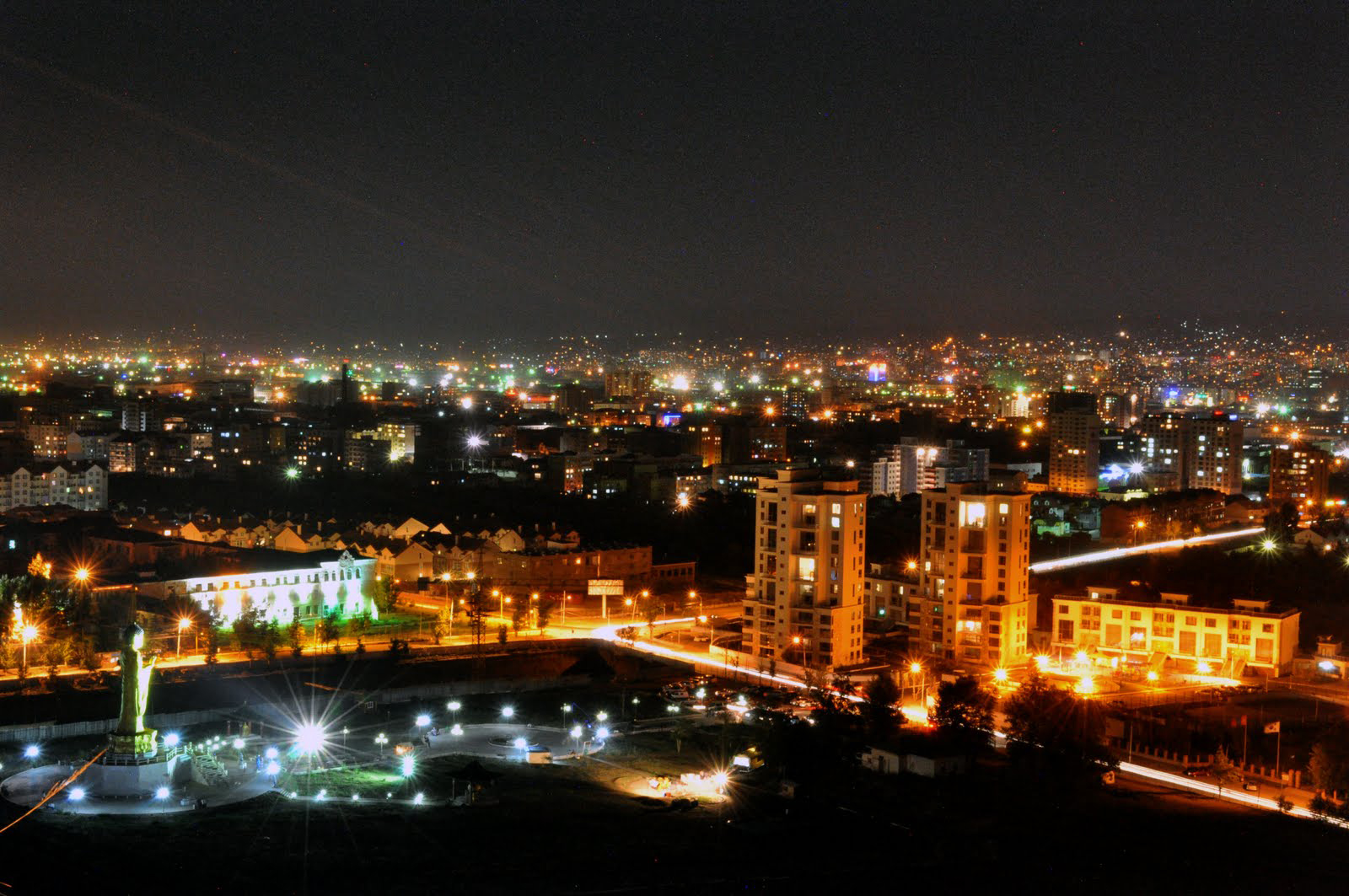
With over one-third of the country's population, Ulaanbaatar is by far Mongolia's largest city. It is also the transport and industrial center of the country. Often shortened to UB by foreigners, Mongolia's capital still has the look and feel of a neglected European city from the 1950s - but not for long. The old Soviet cars and buses are being replaced by newer Japanese models, apartments are being converted into flashy shops and it seems that every young Mongolian now has a mobile phone. Ulaanbaatar prides itself on being an increasingly modern (though still very laid-back) city. Despite all this, men and women still stroll along the main streets in traditional dress.
Built along the river, the Tuul River, and surrounded by picturesque mountains, the center of Ulaanbaatar is dominated by Soviet-style high-rise apartment blocks. Yet about 250,000 locals live in sprawling suburbs on the outskirts of the city, opting to live in traditional Ger.
It is a very pleasant place to visit and to base yourself for trips around the country. The city has interesting monasteries and museums and excellent cultural shows, so try to spend some time here before heading out to the glorious valleys, steppes or desert of Mongolia.
Places to visit: Chinggis Khaan Square, National History Museum, Gandan Monastery, Bogd Khaan Palace Museum, The Zanabazar Museum of Fine Art.
Activities: Monastery and museum visiting, sightseeing, dining, shopping, traditional folk concert
Chinggis Khaan Square
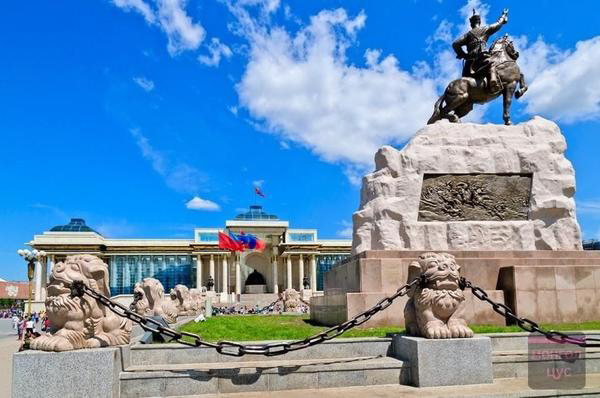
The square features a bronze statue of Sukhbaatar (1921-Revolutionary hero of Mongolia) astride his horse. In 2013 the city authorities changed the name from Sukhbaatar Square to Chinggis Khaan Square, although many citizens still refer to it by the old name.
The enormous marble construction at the north end was completed in 2006 in time for the 800th anniversary of Chinggis Khaan’s coronation. At its centre is a seated bronze Chinggis Khaan Statue, lording it over his nation. He is flanked by Ogedei (on the west) and Khublai (east). Two famed Mongol soldiers (Boorchu and Mukhlai) guard the entrance to the monument.
Behind the Chinggis monument stands Parliament House, which is commonly known as Government House. To the east of the square is the 1970s Soviet-style Cultural Palace, a useful landmark containing the Mongolian National Modern Art Gallery and several other cultural institutions. At the southeast corner of the square, the State Opera & Ballet Theatre. Just south of the Opera House is the symbol of the country's new wealth, Central Tower, which houses luxury shops including Louis Vuitton and Armani.
National History Museum
Exhibits of the museum show the history and culture of Mongols from ages as early as the Stone Age and up to the modern days. Among 15 thousand exhibits of the museum are carpet and silk items of the Xiongnu period and leather boots of a Mongolian soldier of that time.
The 1st floor has some interesting exhibits on petroglyphs, deer stones (stone sculptures of reindeer and other animals) and burial sites from the Xiongnu and Uyghur eras. The 2nd floor houses an outstanding collection of costumes, hats and jewellery, representing most of Mongolia's ethnic groups.
The 3rd floor is a must-see for fans of the Mongol horde. The collection includes real examples of 12th century Mongol Armour, and correspondence between Pope Innocent IV and Guyuk Khaan. Written in Latin and Persian and dated November 13, 1246, it bears the khaan's seal. There is also a display of traditional Mongolian culture with, among other things, a furnished Ger, traditional farming and domestic implements, saddles and musical instruments.
Gandan Monastery
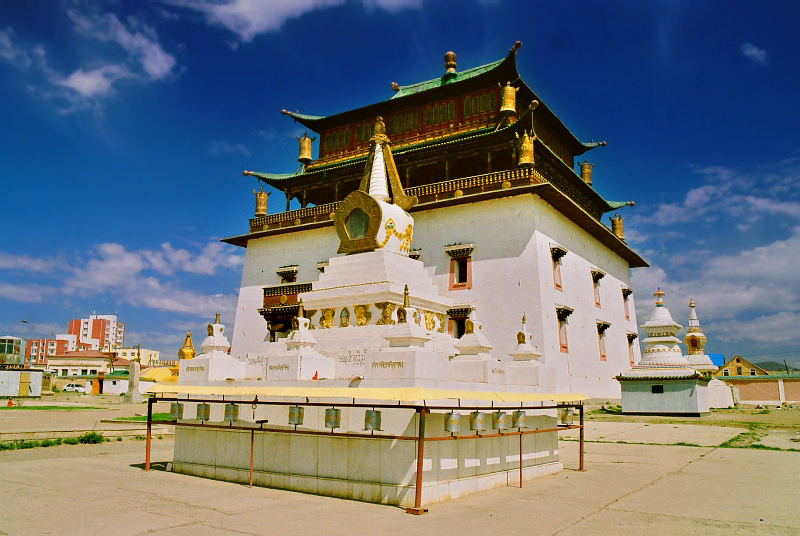 Originally situated in the center of Ulaanbaatar, Gandan Monastery was moved to its present location by the 5th Bogd Jebzundamba in 1838. Over the next century the Monastery grew to include nine datsans or institutes, a library and housed a community of around 5000 monks. Gandan became an important center for learning and practicing Buddha's teachings, not only in Mongolia but for the entire Mahayana Buddhist community. Small mobile monasteries functioned in Mongolia, and in 1838 the Gandantegchinlen monastery was founded as the religious center of Sutra-Tantra Buddhism at the site of Dalkha hill. It grew into a complex of colleges including a college of basic Buddhist teachings, departments of Astrology and Medicine, and as such was the largest center of the Mongolian Buddhism. The first temple of the Monastery was built at the initiative of the Mongolian living Buddha, the Fifth Incarnation Bogdo, Chultem-Jigmid-Dambijantsan. It was constructed by Mongolian masters and made mostly of wood and earth following Mongolian national architectural designs, with gold plated roofes and topmost Buddhist symbolic - decorations. Many of the Boddhisattvas statues and images established in Gandan temple are of significance. In the temple there are a bronze statue of the Lofty Noble Rimpoche Zanabazar - the Mongolian living Buddha of the First Incarnation sculpted by himself at the behest of his mother; the collection of the Buddha's fundamental teachings, the Tripitaka (Gangiur) in 108 volumes; the silver statue of the famous Tsong (Khapa) of Amdo made in XVI century in Western Oirat Mongolia.
Originally situated in the center of Ulaanbaatar, Gandan Monastery was moved to its present location by the 5th Bogd Jebzundamba in 1838. Over the next century the Monastery grew to include nine datsans or institutes, a library and housed a community of around 5000 monks. Gandan became an important center for learning and practicing Buddha's teachings, not only in Mongolia but for the entire Mahayana Buddhist community. Small mobile monasteries functioned in Mongolia, and in 1838 the Gandantegchinlen monastery was founded as the religious center of Sutra-Tantra Buddhism at the site of Dalkha hill. It grew into a complex of colleges including a college of basic Buddhist teachings, departments of Astrology and Medicine, and as such was the largest center of the Mongolian Buddhism. The first temple of the Monastery was built at the initiative of the Mongolian living Buddha, the Fifth Incarnation Bogdo, Chultem-Jigmid-Dambijantsan. It was constructed by Mongolian masters and made mostly of wood and earth following Mongolian national architectural designs, with gold plated roofes and topmost Buddhist symbolic - decorations. Many of the Boddhisattvas statues and images established in Gandan temple are of significance. In the temple there are a bronze statue of the Lofty Noble Rimpoche Zanabazar - the Mongolian living Buddha of the First Incarnation sculpted by himself at the behest of his mother; the collection of the Buddha's fundamental teachings, the Tripitaka (Gangiur) in 108 volumes; the silver statue of the famous Tsong (Khapa) of Amdo made in XVI century in Western Oirat Mongolia.
In 1938, the communists suppressed religious communities in Mongolia. They destroyed around 700 monasteries, though a handful were turned into museums. The monks were killed, jailed, or forced to join the army or laity. Five temples of Gandan Monastery were destroyed. The remaining temples were used to accommodate Russian officials or used as barns to keep their horses. In 1944 after a petition from several monks, Gandan Monastery was reopened but its functions were carried out under the strict supervision of the socialist government. In 1990, after the Democratic Revolution and with Buddhism flourishing once more, Gandan Monastery embarked on an ambitious restoration program around the country. There are currently 10 datsans and temples operating at Gandan Monastery, and approximately 900 monks.
The Migjid Janraisig Temple is an important part of Gandan Monastery. The temple houses the majestic new gilded statue of Migjid Janraisig, decorated with jewels. This 26 meter high 20 ton statue is a copy of another statue that was destroyed in the 1920's by communists. The statue was built with donations of Mongolian people as symbol of Buddhist revival in the mid 1990's.
Bogd khaan Palace Museum
 The Winter Palace of Bogd Khaan - one of the first museums in Mongolia - was built in 1924. It used to be a winter residence of the last Bogd Khaan of Mongolia, Javzandamba. The palace compound was built between 1893 and 1903, and is well known for its Gate of Peace, Temple and personal library of Bogd Khaan. Among the museum's exhibits are sculptures by Mongolia's first Bogdo Zanabazar, the famous Taras. The museum has 21 invaluable sculptures of Taras. The collections at the Palace Museum numbers over 8,000 exhibits, of these 72 are certified by the State as unique but others are priceless artifacts.
The Winter Palace of Bogd Khaan - one of the first museums in Mongolia - was built in 1924. It used to be a winter residence of the last Bogd Khaan of Mongolia, Javzandamba. The palace compound was built between 1893 and 1903, and is well known for its Gate of Peace, Temple and personal library of Bogd Khaan. Among the museum's exhibits are sculptures by Mongolia's first Bogdo Zanabazar, the famous Taras. The museum has 21 invaluable sculptures of Taras. The collections at the Palace Museum numbers over 8,000 exhibits, of these 72 are certified by the State as unique but others are priceless artifacts.
This is the only remaining palace out of four residences where Bogd Khaan, the last Mongolian ruler, resided. This palace now displays the collection of personal belongings of the last Khaan and his wife. The museum offers a wide variety of Buddhist arts.
The Bogd Khaan Palace Museum comprises of two parts, which are the summer palace with seven temples and pagodas and the winter palace, a two story, white construction built in a European architectural style.
There are mostly ancient statues of gods in the summer palace. Hence every year two great religious rituals are used here and staged to worship the sky and water spirits. There is also a tent decorated with sculptures of birds, animals and horseman.
In the winter palace, built as a project by architects of Tsarist Russia (1893-1903), the Bogd Khaan along with his queen, Dondogdulam Khatan (1874-1923) spent the wintertime for 20 years.
The Palace Museum preserves priceless historical and cultural monuments of the Mongolian State and religion from the 17th to 20th Centuries, together with artifacts created by the foremost masters of that time, Zanabazar in particular, ranging from statues of gods, thangkas, and papier-mache.
The Zanabazar Museum of Fine Art
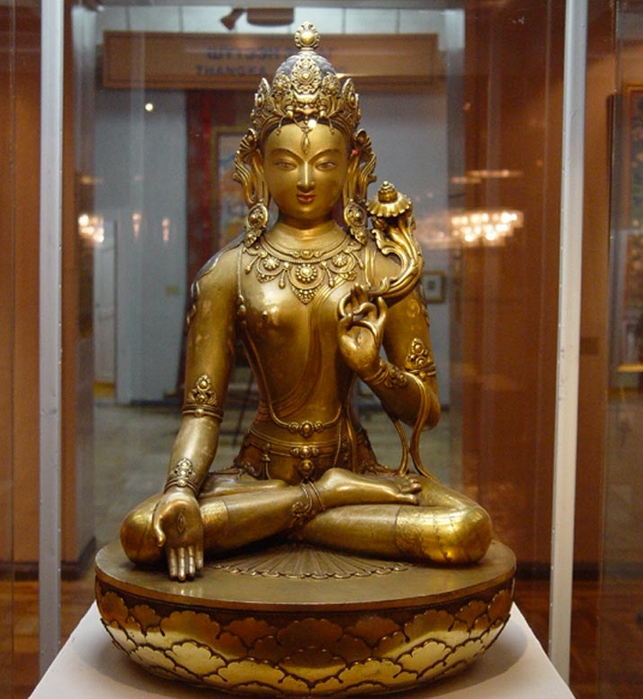
Zanabazar Museum of Fine Art in Ulaanbaatar was founded in 1966. Visitors can enjoy works of Mongolia's famous artists, and sculptors who lived before or in the early 20th century. Sculptures by Mongolia's first Bogd (living Buddha) and famous sculptor Zanabazar ("Five Gods" and "Taras"), as well as appliqués and sculptures in wood and stone by talented Mongolian craftsmen are among the 10 thousand exhibits of the museum. 25 of the 45 most precious works of art created by Mongolia's artists can be found in the museum.
The Zanabazar Museum of Fine Arts has an excellent collection of paintings, carvings and sculptures, including many by the revered sculptor and artist Zanabazar. It also contains other rare and sometimes old - religious exhibits such as scroll paintings (thangka) and Buddhist statues, representing the best display of its kind in Mongolia.
At the top of the stairs is a glass folder with a detailed explanation of Zanabazar and his work. There are some fine examples of the sculptor's work including five Dhyani, or Contemplation, Buddha’s (cast in 1683) and Tara in her 21 manifestations.
Also worth checking out are the wonderful tsam masks (worn by monks during religious ceremonies) and the intricate paintings, One Day in Mongolia and The Airag Feast, by renowned artist В. Sharav. These depict almost every aspect of nomadic life. The ground floor has some copies of portraits of the great khaans (kings) and some 7th century Turkic carvings.
AROUND ULAANBAATAR
Places to visit: Terelj National Park, Chinggis Khaan Statue, 13 th Century Complex Park, Bogd Khaan National Park, Hustai National Park, Gun Galuut Nature Reserve
Activities: Monastery visiting, hiking, rafting, horse riding, camel riding, bird watching, wildlife viewing, fishing, nomadic culture experiencing, camping in the wild.
Terelj National Park
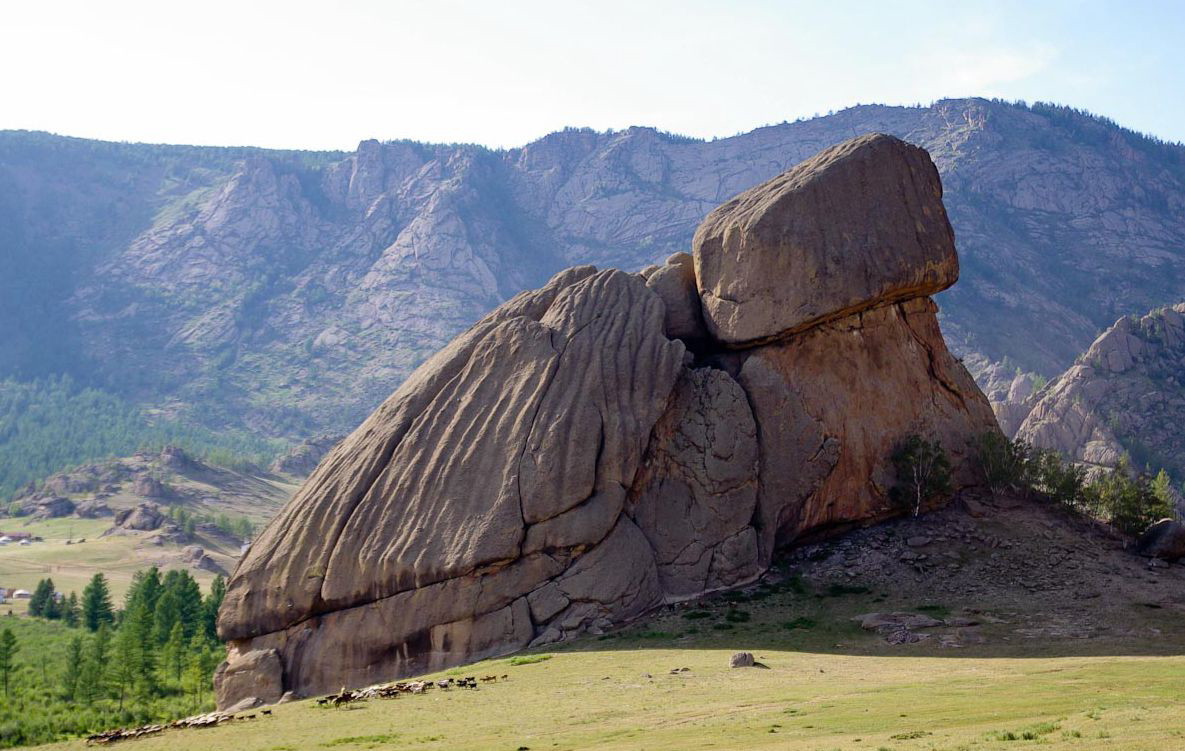
Terelj, about 80km north-east of Ulaanbaatar, is a deservedly popular destination. At 1600m, the area is cool and the alpine scenery is magnificent, and there are great opportunities for hiking, rock climbing, swimming, rafting, horse riding, visiting nomad family and so on. Most visited are the turtle rock and the dinosaur’s park.
Terelj was first developed for tourism in 1964 and 30 years later it became part of the Gorkhi-Terelj National Park. To the north-east, the park joins into the Khan Khentii Strictly Protected Area, comprising over 1.2 million hectares of the Tov, Selenge and Khentii aimags. The Khan Khentii park is almost completely uninhabited by humans, but it is home to endangered species of moose, brown bear and weasel, to name but a few, and to over 250 species of birds. Also there is a small Buddhist meditation temple Ariyabal nestled in the park’s rocky mountainside. The entrance of the gate is accessible by car, hiking or on horseback. The distance between the gate and the actual temple is about 1 km and it is only accessible by walking. To get to the top, you would cross the suspension bridge and climb up on 108 stairs, according to Buddhist prayer beads. This small hike is seen as a ritual to cleanse one’s sins. The temple, when observed from distance, can be seen as a beautiful white elephant and the staircase looks as if the dangling elephant’s trunk. From the top, you can enjoy the breathtaking view overlooking the Terelj National Park.
Chinggis Khaan Statue
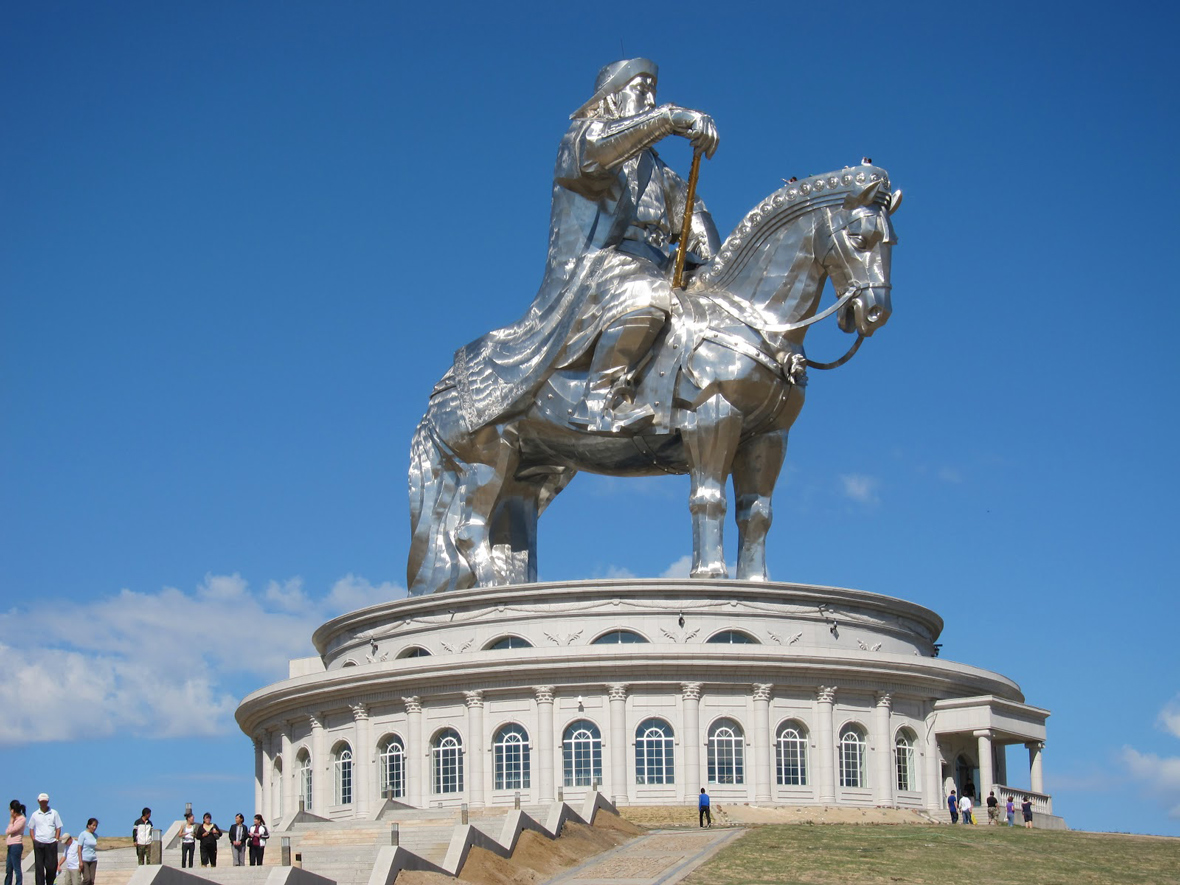 A gigantic statue of Chinggis Khaan riding on horseback was erected in 2008 on the bank of the Tuul River at Tsonjin Boldog, 54 km east of the Mongolian capital Ulaanbaatar, where according to legend, he found a golden whip.
A gigantic statue of Chinggis Khaan riding on horseback was erected in 2008 on the bank of the Tuul River at Tsonjin Boldog, 54 km east of the Mongolian capital Ulaanbaatar, where according to legend, he found a golden whip.
Here, Temujin (Chinggis Khaan's childhood name) becoming the great Khaan who conquered half the world after overcoming difficulties in his childhood when he lost his father, found a whip on the way back from Khereid's Toiril Khan, where he had gone to ask for help when Mergid had captured his wife in 1177. Finding a whip is perceived by Mongolians as a good omen. Therefore, finding the whip, Chinggis Khaan became greedy seeing it as a path being opened to the great cause.
The haughty and yet honorable statue is surrounded by 36 columns representing 36 Mongolian Khaans. The entire edifice is covered in 250 tonne of steel. Visitors will ascend to the exhibition hall using an elevator at the back of the horse and will walk to the horse's head passing through its chest and the back of its neck from where they will have an excellent panoramic view over the complex area and the scenery beyond. The statue is currently largest equastrian statue in the world.
13 th Century Complex Park
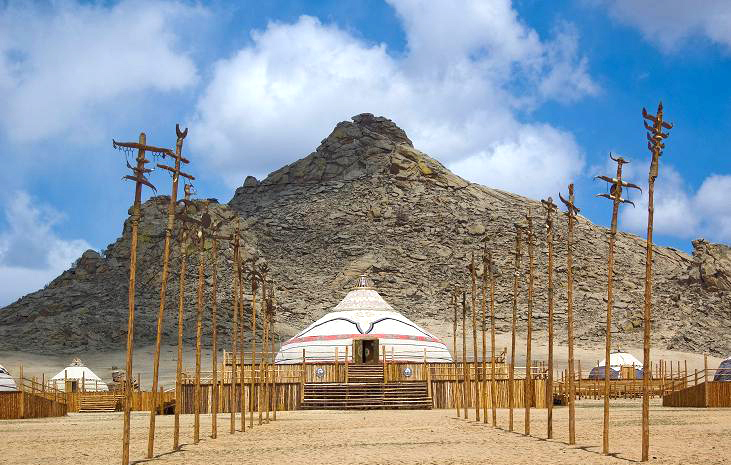
“13th Century National Park” is located in Erdene country, Yol Mountain 96km from Ulaanbaatar. The goal of “13th century” national park is build and establish real-time micro kingdom to make the lively feeling for its guests during their stay by genuinely providing true environment of the way of living and working of the 13th century. Visitors can enjoy annual celebrations, customs such as making felt cover for Gers, sling wool, sacred ceremony to praise flag, heaven by sacrificing, wedding, weeping camel, mare milking, sealing folks and organizing three games of men. Here the guests can dine with Khaans and Queens visit the residents of lords and learn to write in Mongolian scripts and play in horse-headed fiddle /Morin khuur/.
“13th Century National Park” consisted with six camps and tribes provide the service to the tourists.
Bogd Khaan Mountain National Park
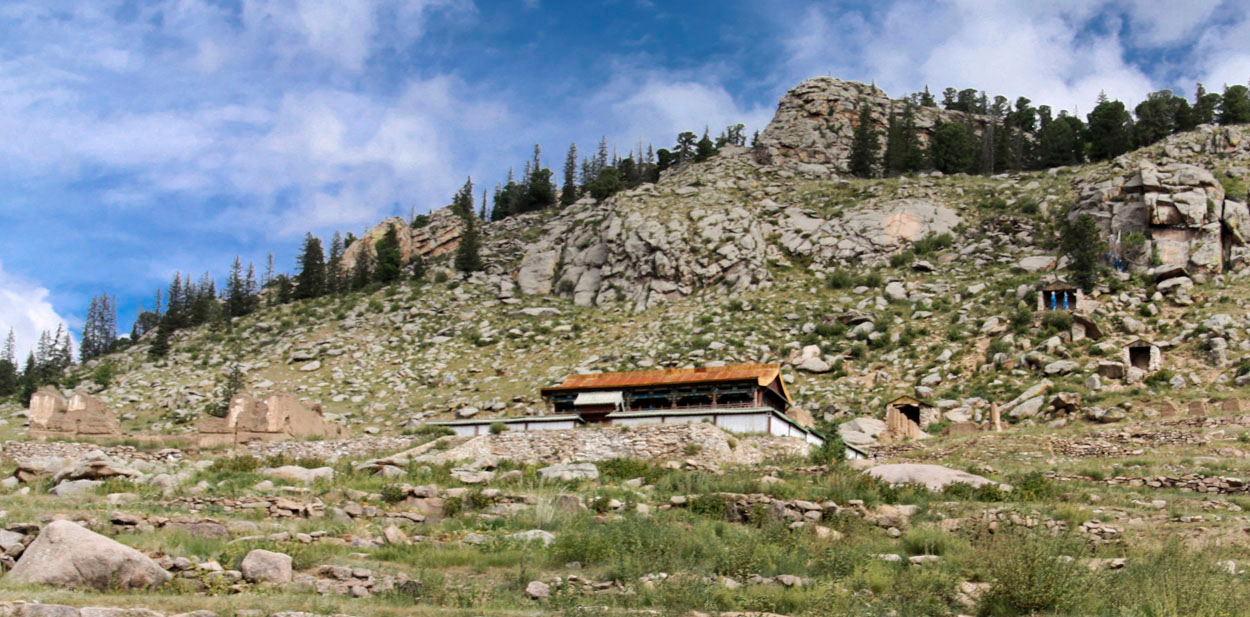
One of the two most popular destinations outside of Ulaanbaatar is Mt.Bogd khaan National Park. Lying to the south of Ulaanbaatar, Bogd Khaan Mountain has been a national park of the country since 300 years ago. The main entrance to the National Park is 46 kilometers to the south west of the city. With its nature and wildlife intact, Bogd Khaan Mountain boasts its beautiful scenery with green forests of pine, cedar, larch and birch covering the mountain.
Place is ideal for hiking, horse riding and climbing as well as exploring the nomads daily lifestyle.
Also you can visit the Manzushir monastery, 18-th century monastery in Southern reserve. Established in 1733, it had over 20 temples and was once home to at least 300 monks.
Hustai National Park
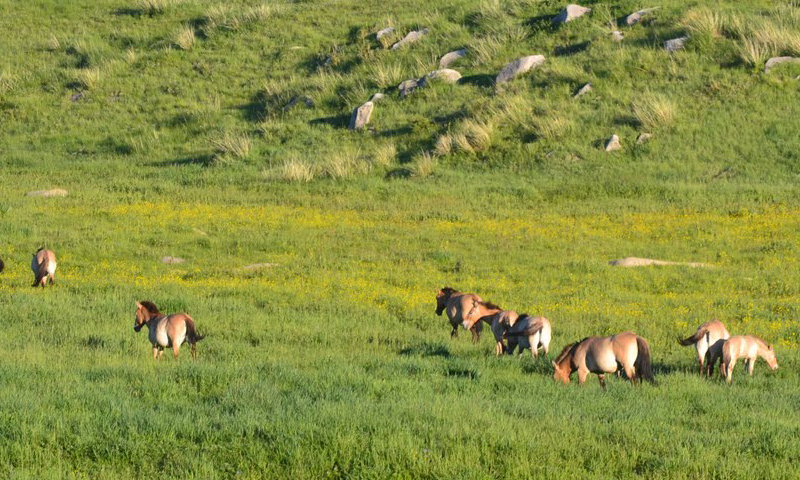 The Hustai National Park protected area lies 100km southwest of Ulaanbaatar and was established in 1993 to preserve Mongolia’s wild takhi (przewalski’s) horses and the environment in which they live. The takhi horse is unique to Mongolia where it existed until the 1960s. It is believed these horses have direct genetic links to prehistoric horses. After the sad extinction of the takhi horses in the wild, these beautiful animals have been reintroduced from captivity and they have taken well to their new freedom. They are not particularly afraid of humans and the harems (one stallion and several mares) are known to come quite close if visitors are quiet and calm. On the territory of Hustai National Park and its buffer zone there are many historical monuments exist like: monument ensemble of Ungut-famous with it is large number of man like figures, which belongs to 6-8 th century and. many other sepultures, rectangular tombs and ruin of old monastery.
The Hustai National Park protected area lies 100km southwest of Ulaanbaatar and was established in 1993 to preserve Mongolia’s wild takhi (przewalski’s) horses and the environment in which they live. The takhi horse is unique to Mongolia where it existed until the 1960s. It is believed these horses have direct genetic links to prehistoric horses. After the sad extinction of the takhi horses in the wild, these beautiful animals have been reintroduced from captivity and they have taken well to their new freedom. They are not particularly afraid of humans and the harems (one stallion and several mares) are known to come quite close if visitors are quiet and calm. On the territory of Hustai National Park and its buffer zone there are many historical monuments exist like: monument ensemble of Ungut-famous with it is large number of man like figures, which belongs to 6-8 th century and. many other sepultures, rectangular tombs and ruin of old monastery.
Gun Galuut Nature Reserve
 It is one of the most popular eco destinations of Mongolia and covers about 20000 hectare. Amazingly, Gun-Galuut is the state combined from diversity of ecosystem although it owns comparatively small area. The harmonized complex of high mountains, steppes, rivers, lakes and wetlands as well are kept enough as its original condition. It is a home to endangered wild Mountain sheep-Argali, White napped crane, Siberian white crane, Hooded crane and the rare black stork, Azian heron, Whooper swan, Swan goose and so on. Over 200 Argali sheep inhabit peacefully in Gun Galuut now. Whoever visiting enjoys to see Gun-Galuut vast steppe seems to meet the sky, the imposing mountains Baits and Berkh, a home land of rare creatures, Ikh-Gun and Ayaga lakes, a paradise of birds, Kherlen, the longest river of Mongolia and Tsengiin Burd wetland, in where water and wetland birds lay their eggs. Place is ideal for hiking, horse and camel riding, bird watching and experiencing lifestyle of local nomad people, rafting and fishing, camping in the wild or just watching wild animals and enjoying photo opportunities.
It is one of the most popular eco destinations of Mongolia and covers about 20000 hectare. Amazingly, Gun-Galuut is the state combined from diversity of ecosystem although it owns comparatively small area. The harmonized complex of high mountains, steppes, rivers, lakes and wetlands as well are kept enough as its original condition. It is a home to endangered wild Mountain sheep-Argali, White napped crane, Siberian white crane, Hooded crane and the rare black stork, Azian heron, Whooper swan, Swan goose and so on. Over 200 Argali sheep inhabit peacefully in Gun Galuut now. Whoever visiting enjoys to see Gun-Galuut vast steppe seems to meet the sky, the imposing mountains Baits and Berkh, a home land of rare creatures, Ikh-Gun and Ayaga lakes, a paradise of birds, Kherlen, the longest river of Mongolia and Tsengiin Burd wetland, in where water and wetland birds lay their eggs. Place is ideal for hiking, horse and camel riding, bird watching and experiencing lifestyle of local nomad people, rafting and fishing, camping in the wild or just watching wild animals and enjoying photo opportunities.
Recommended


Mongolian winter is the most incredible winter that one might experience and there is plenty to see and enjoy during a winter travel. Glittering white snow, clear fresh air, sun, and little chills are the image of Mongolian winter. Taking this fan...
Duration: 3 Days / 2 Nights
Destination: Gobi - Central


All of Mongolians celebrate the Lunar New Year, which is called in Mongolia “Tsagaan Sar” or the “White Moon”. It is widely celebrated throughout the country around January or February according to the combination of Solar-...





